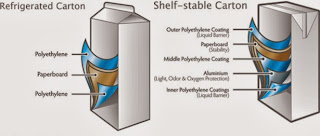We have already decided that we don't want to have a plastic film wrapped around our bottle as we feel that this would go against being environmentally friendly and would make the use of a compostable bioplastic completely pointless. Therefore we need to find another way to brand our bottle with our name, logo and all other necessary information. We have looked into the idea of engraving into the bioplastic, however after doing some research we have found that this may not be that easy, especially as we would like to have a colour engraved into the clear plastic.
http://science.howstuffworks.com/environmental/green-science/future-of-bioplastics2.htm
http://www.chemanager-online.com/en/topics/chemicals-distribution/colorful-world-bioplastics
The production of bioplastic can be up to 100% more expensive than the production of petrochemical plastic and although we have no actual budget, we would like our idea to be as realistic as possible. We would be happy to spend slightly more money in order to make our product eco-friendly, however we feel that adding colour on top of this would be unrealistically expensive. The production of colourful bioplastics is also quite difficult and can limit the compostable features of the plastic so because of this, we will start to look at other ways to add colour to our clear bioplastic box.
Another option, which we have briefly previously mentioned, would be to use a transfer/sticker directly onto the box with our branded logo on it. We hadn't before considered this idea in depth as we were thinking of using coloured plastic but after deciding that coloured plastic wouldn't be feasible we have done further research into this idea.
We like the simplicity of each of these designs and how striking they are and because simple is one of our brand values, we feel as though this would be a good way for us to design our water brand. The colours in the logo are emphasised more because they are clearly and cleanly presented on the clear bottle, helping to emphasise the brand.
After carrying out further market research, we have come across another issue that we feel needs to be addressed. We want a water brand that will stand out on the shelf amongst the current water bottles so that consumers will want to buy it and designing a box shape as opposed to a standard bottle will stand out quite a bit and give our brand something unique. However, because all of the bottles/our box will be made of plastic, they will all look quite similar and we don't feel as though it would be unique enough. Therefore, we have started to rethink the material that we use.
We have previously considered paper/cardboard cartons but went against this idea because we felt as though consumers wouldn't like not being able to see the water inside. However, after reassessing, we thought about how juice and milk are sold in cartons and it doesn't seem to bother consumers, so why should it with water? Using a paper/cardboard carton would still be in keeping with being eco-friendly and it would also solve our issue of getting colour onto clear bioplastic that was proving difficult and expensive. Even though this idea goes against our first research findings, we feel as though having a brand that stands out and gets noticed most is more important than being able to see the water inside.
Although we like the idea of using a carton design, we have already started designing a square box and want to stay with this idea as we really like it and like how our logo could look on it. Creating a paper/cardboard box of water would be totally different to anything else that is currently available and would really give our brand something extra which would help give it a unique selling point.
A typical shelf-stable carton is made of 3 things;
- 74% paper
- 22% plastic
- 4% alluminium
A typical refrigerated carton is made of only 2 things;
- 80% paper
- 20% plastic

We think that a refrigerated carton is the best type of carton for us. We have decided this because a refrigerated carton is as we believe, more eco-friendly. When each of the materials are broken down separately, aluminum has the least purpose and therefore we feel as though it isn't a necessary material.
- Paper - Breaks down into paper fibre that is used for tissues and office paper.
- Plastic - Breaks down to be used for shipping crates and building materials.
We would use the plastic and paper combination that makes up a refrigerated carton, however we won't use the standard refrigerated carton shape, we will use our own designed box.





No comments:
Post a Comment